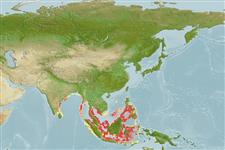Common names from other countries
Klassifizierung / Names
Namen | Synonyme | Catalog of Fishes(Gattung, Arten) | ITIS | CoL | WoRMS | Cloffa
>
Gobiiformes (Gobies) >
Gobiidae (Gobies) > Gobiinae
Etymology: Trimma: Greek, trimma, -atos = something crushed (Ref. 45335); fucatum: Name from Latin ‘fucatus’, meaning painted, coloured, or rouged; referring to the red markings on and around the preopercle..
More on authors: Winterbottom & Southcott.
Environment: milieu / climate zone / depth range / distribution range
Ökologie
seewasser riff-verbunden; tiefenbereich 0 - 23 m (Ref. 59340). Tropical
Indo-West Pacific: Andaman Sea, Phuket, Thailand, Myanmar and Indonesia.
Size / Gewicht / Alter
Maturity: Lm ? range ? - ? cm
Max length : 2.0 cm SL Männchen/unbestimmt; (Ref. 59340)
Rückenflossenstacheln (insgesamt) : 7; Rückenflossenweichstrahlen (insgesamt) : 7 - 9; Afterflossenstacheln: 1; Afterflossenweichstrahlen: 7 - 8. This species is distinguished by having predorsal scales; second and third dorsal spines not elongated; with interorbital and postorbital trenches; opercular scales 2; a single dichotomous branch in the fifth pelvic-fin ray; when alive has three or four rows of yellow to orange blotches along the body and a narrow red bar on the vertical limb of the preopercle (Ref. 59340); characterized further by having longitudinal scale series 21-25; predorsal scales 4-5; cheek without scales; depth of body 4.3 in SL (Ref. 90102).
Collected specimens came from patch reefs and coral slopes with diverse coral cover, except for the 3 specimens collected from a steep (45°) wall of large boulders with little algal or coral growth (Ref. 59340).
Life cycle and mating behavior
Maturities | Fortpflanzung | Spawnings | Egg(s) | Fecundities | Larven
Winterbottom, R. and L. Southcott, 2007. Two new species of the genus Trimma (Percomorpha: Gobioidei) from western Thailand. aqua, Int. J. Ichthyol. 13(2):69-76. (Ref. 59340)
IUCN Rote Liste Status (Ref. 130435)
CITES (Ref. 128078)
Not Evaluated
Bedrohung für Menschen
Harmless
Nutzung durch Menschen
Tools
Zusatzinformationen
Download XML
Internet Quellen
Estimates based on models
Preferred temperature (Ref.
115969): 28.6 - 29.3, mean 29 (based on 446 cells).
Phylogenetic diversity index (Ref.
82804): PD
50 = 0.5000 [Uniqueness, from 0.5 = low to 2.0 = high].
Bayesian length-weight: a=0.01023 (0.00477 - 0.02194), b=3.02 (2.84 - 3.20), in cm Total Length, based on LWR estimates for this (Sub)family-body shape (Ref.
93245).
Widerstandsfähigkeit (Ref.
120179): hoch, Verdopplung der Population dauert weniger als 15 Monate. (Preliminary K or Fecundity.).
Fishing Vulnerability (Ref.
59153): Low vulnerability (10 of 100).
